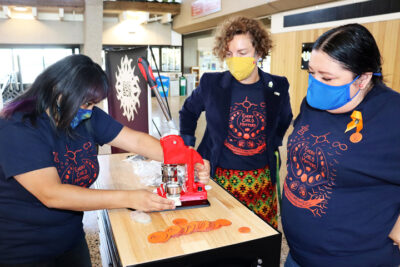Events mark National Day for Truth and Reconciliation
By Herald on October 1, 2021.
 Sara Hossain makes Every Child Matters buttons in the University of Lethbridge Atrium while Mary Greenshields and Jodie Flamand Tailfeathers looks on. The buttons were being made and handed out to students as the university held a number of activities this week to recognize the National Day for Truth and Reconciliation. Herald photo by Al Beeber
Sara Hossain makes Every Child Matters buttons in the University of Lethbridge Atrium while Mary Greenshields and Jodie Flamand Tailfeathers looks on. The buttons were being made and handed out to students as the university held a number of activities this week to recognize the National Day for Truth and Reconciliation. Herald photo by Al BeeberAl Beeber – Lethbridge Herald
An online presentation by the Lethbridge Public Library Thursday on the National Day for Truth and Reconciliation gave audience members a chance to hear about the reason for the day and create a dialogue to discuss the legacies of the residential school system.
Hosted by library staffers Linda WeaselHead, Madeson Singh and Marilyn Contois, the Zoom session also gave insights into the library’s creation of paper doll kits, which quickly sold out prompting the library to create online instructions and a template so people could make their own.
The session included a short video presentation by Linda Webstad, who grew up near Williams Lake, B.C. and was sent to Saint Joseph Residential School at the age of six.
Webstad details how a new orange shirt given to her by her grandmother for her first day in school was taken from her and she never saw it again.
She grew up with her grandmother on a reserve until she turned 10 and then moved with an aunt when she finished university.
When she turned six, she was sent to the school which they called the Mission.
“When I got there I was stripped, my clothing taken away, including my new orange shirt and I never saw it again. I was no longer excited to be going to school, I wanted to go home to granny. I had to stay there for 300 sleeps. No matter how much all of us little kids cried, it didn’t matter. No one listened to us, our feelings didn’t matter, Webstad said in the video, recalling that her grandmother and mother both attended the mission for 10 years each.
“Today is a day to honour and remember residential school survivors and their families. Every child matters… We must also remember those children that never made it and are no longer with us. Today is a day for survivors to tell their stories and for us to listen with open hearts,” she said in the video.
The idea for the dolls came about when WeaselHead was talking to her sister in Montana who had gone to get her brakes fixed. To occupy her granddaughter, she showed her how to make a paper doll out of a scrap paper bag and duct tape.
The sister sent WeaselHead a picture and she showed it to Singh and suggested some should be made for Orange Shirt Day, using scraps from sewing baskets.
That led to the creation of 50 paper doll kits at the library which sold out in a day.
“Madison put a lot of time and love into it. Each bag of kits, she hand-lettered them and she thought about each of the children who didn’t have the opportunity” to survive the schools.
Singh said during September, a display was created of faceless paper dolls and library staff wanted to find a way to bring awareness to the children who didn’t make it home, she said, as well as the survivors and the families.
“We decided we would like to create an experience for our communities to engage with reconciliation. So we put together 50 kits” with different materials, she said.
“As I put together each kit, I just thought about how the Indigenous children that didn’t get a chance to be children and didn’t get a chance to do things they loved,” Singh said.
Singh said “it’s very important that we think about ways that we can implement reconciliation in our lives.
One way to do that, said WeaselHead, is to learn to speak the Indigenous language that is common wherever people live.
She recalled moving to the the Blood Reserve in 1989 and her surprise that so many spoke Blackfoot at the Shot Both Sides building in Standoff.
“I was so impressed because where I came from, Montana, we had basically lost our language and there was a huge revival with my nephew starting a school down there. Now the young people are starting to write it on Facebook and so that movement is starting. But as non-Indigenous people, the more you can learn about the language and kind of get the ear for it, that would really be good. I’m not fluent in Blackfoot, I was denied my own language so I always have this big hole in my soul that I was denied my language.
“My parents were told from the boarding school, probably the same thing happened in residential school, what’s the use of learning your language? Where are you going to use it?” she said recalling how nuns told them to learn English properly.
“My husband experienced the same thing except with him, they would do it secretly and they kept their language and they would talk about the nun and some of them actually got punished really severely,” WeaselHead said.
“It’s really important that we know those stories,” she said of residential school survivors, “so that we can understand why some of the people end up on the streets. They didn’t start out that way,” WeaselHead said.
“So if there’s anything you do, learn the language and learn the land that you’re on,” she said to non-Indigenous residents.
“Those are the two I would stress. Help us to recover our language in whatever way you can. We’re not expecting fluency from people.”
She said the City’s “OKI” sign is a start but people need to learn more.
The Galt Museum, said Singh, created a Blackfoot language workbook that people could access.
Follow @albeebHerald on Twitter.
29-28




